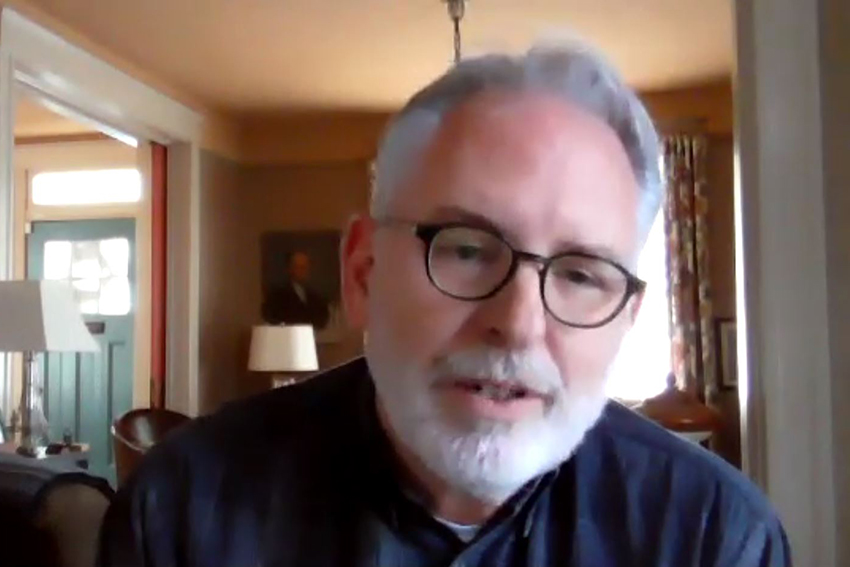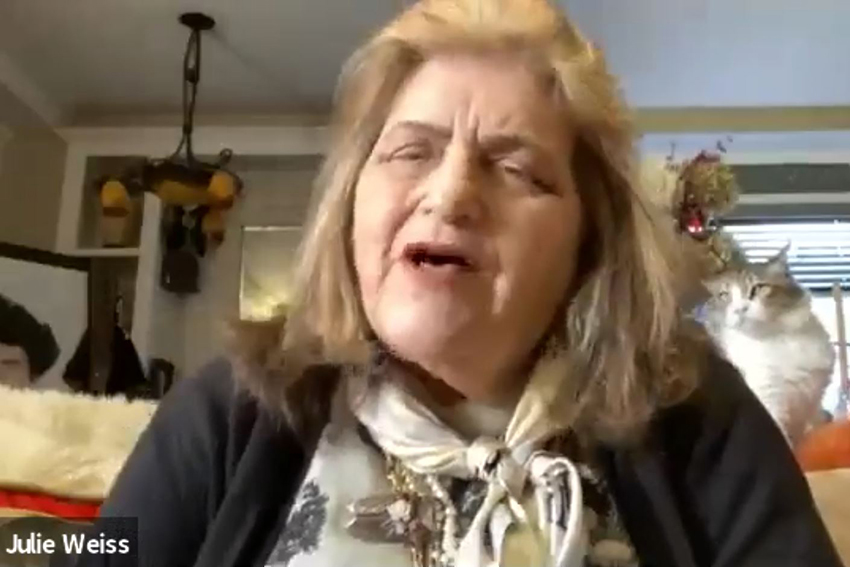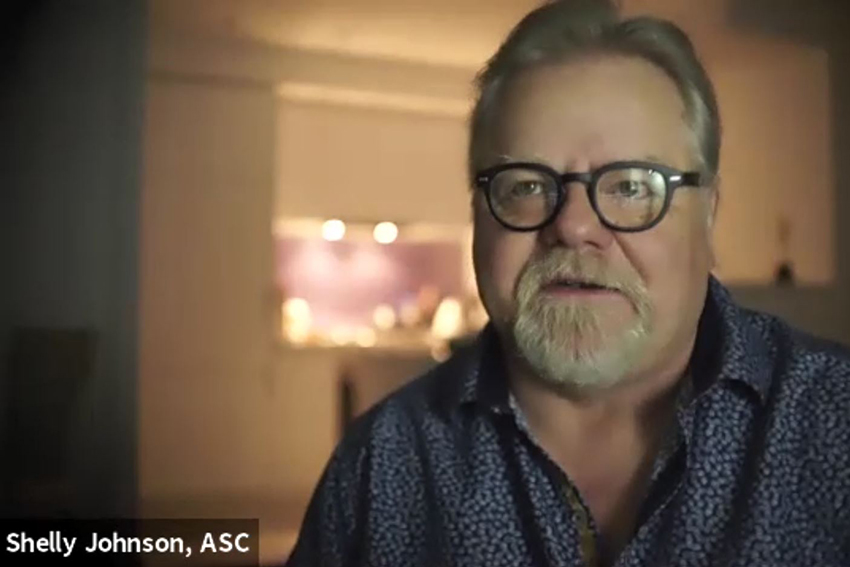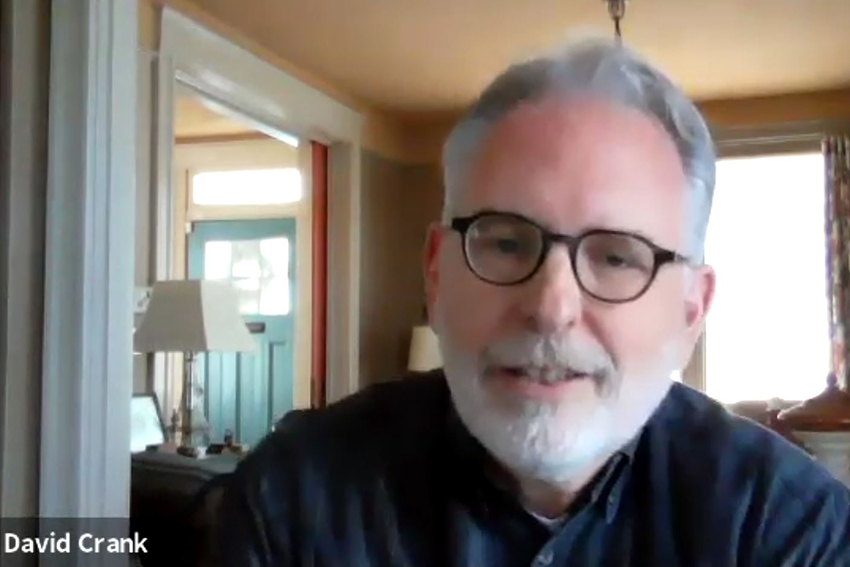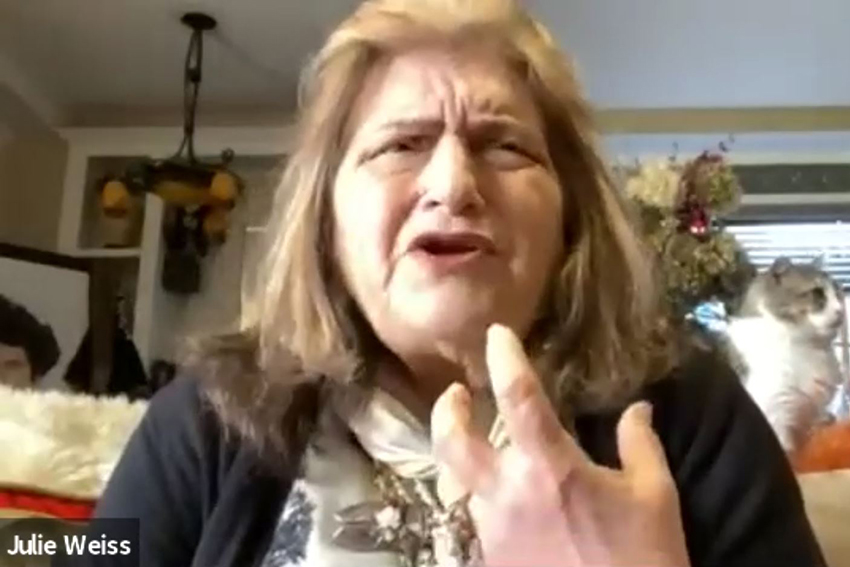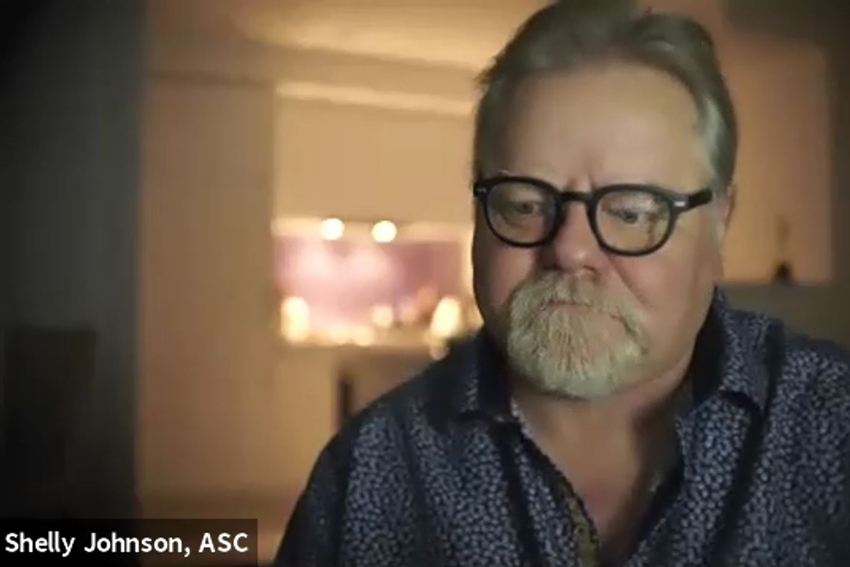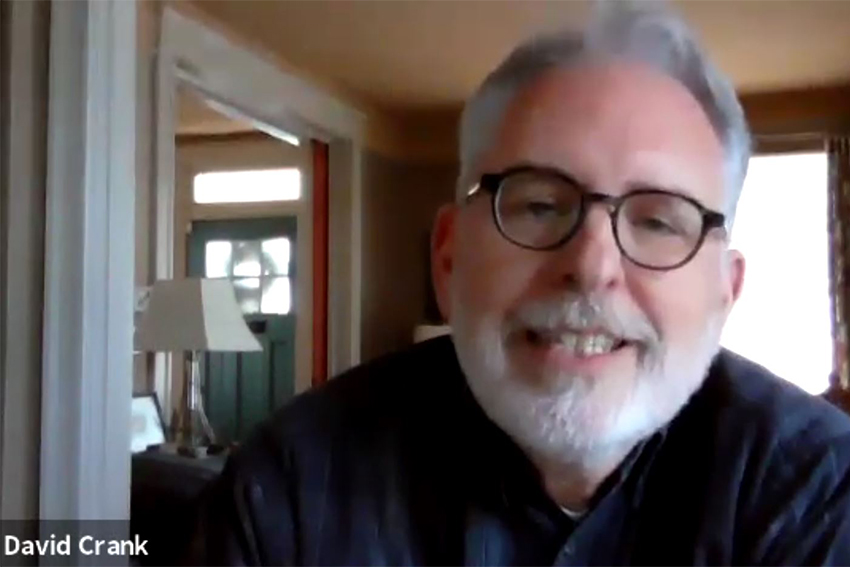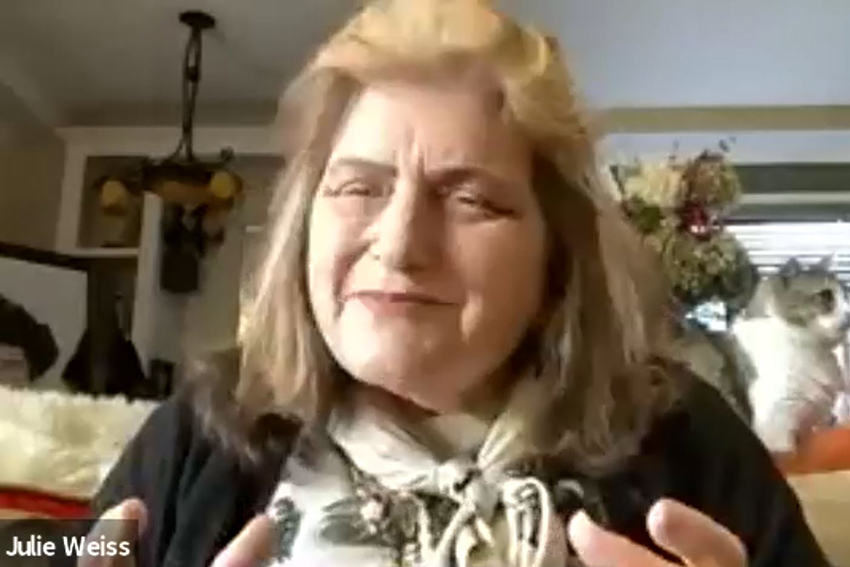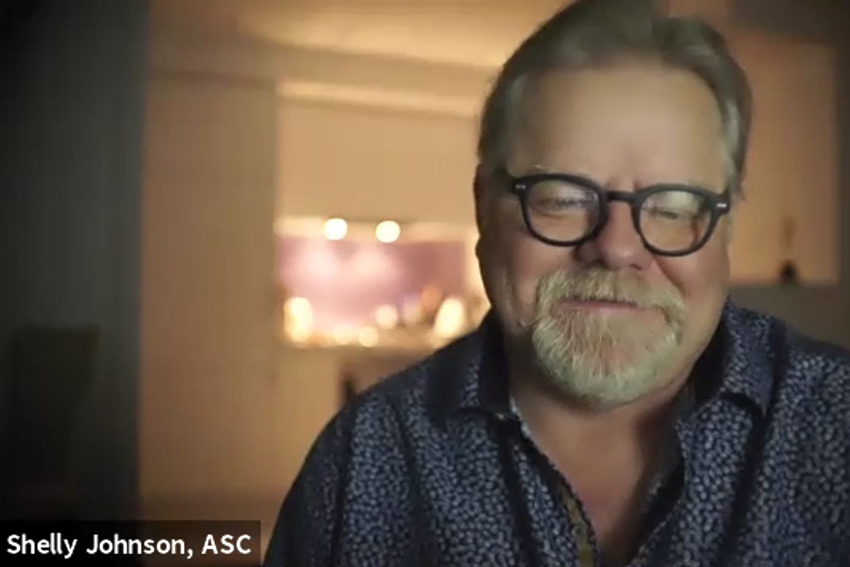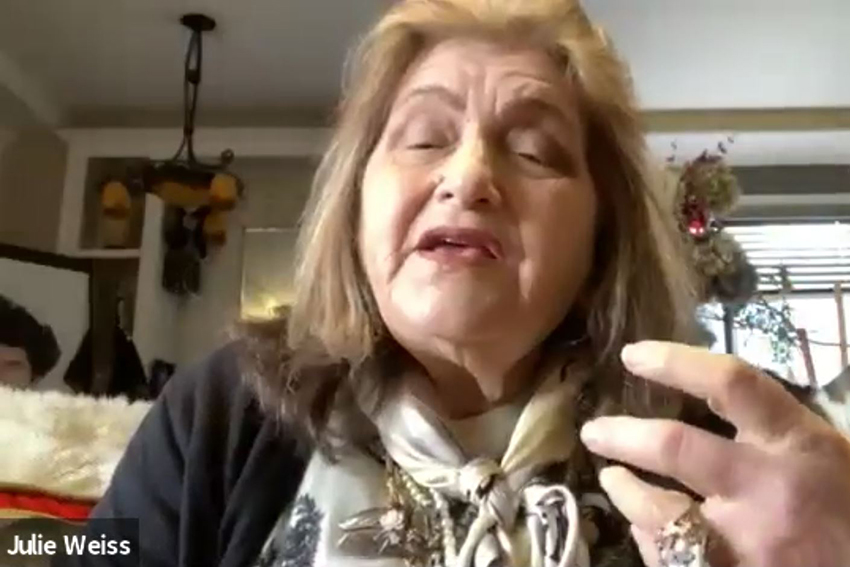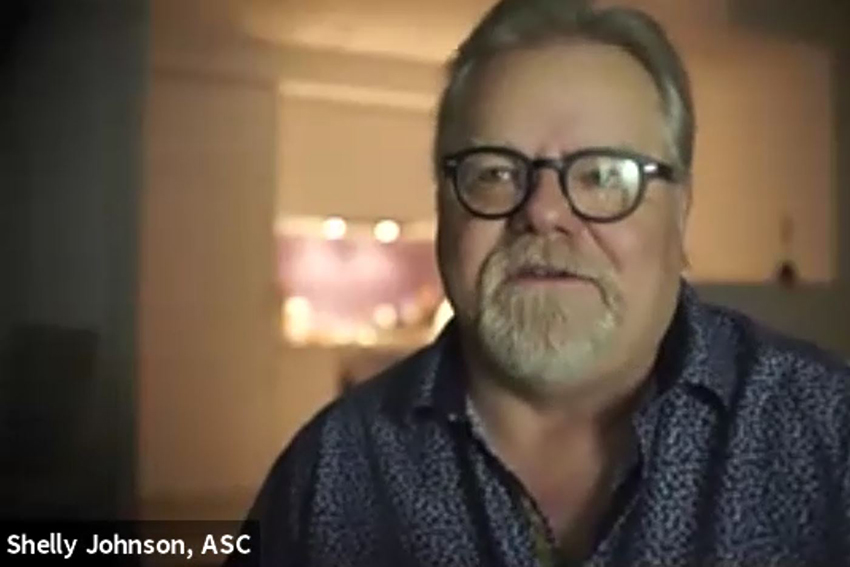AppleTV+ - GreyHound – Shelly Johnson, Julie Weiss, David Crank virtual press conference
By Mulder, Zoom Event, 08 january 2021
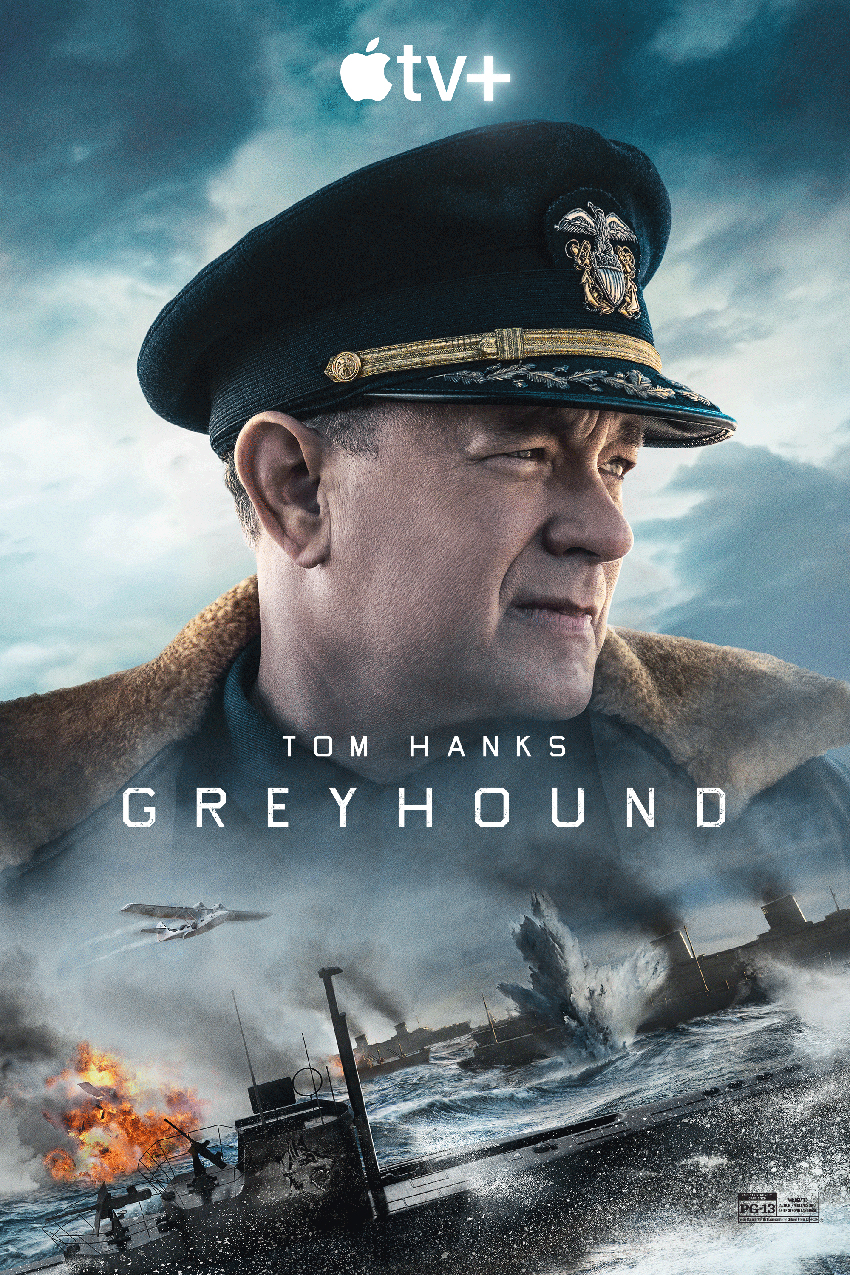
Greyhound is a 2020 American war film directed by Aaron Schneider and starring Tom Hanks, who also wrote the screenplay. The film is based on the 1955 novel The Good Shepherd by C. S. Forester, and also stars Stephen Graham, Rob Morgan, and Elisabeth Shue. The plot follows a commander of the US Navy on his first war-time assignment in command of a multi-national escort group defending a merchant ship convoy under attack by submarines in early-1942 during the Battle of the Atlantic, only months after the U.S. officially entered World War II. Greyhound was initially scheduled to be theatrically released in the United States on June 12, 2020 by Sony Pictures Releasing, but was eventually cancelled due to the COVID-19 pandemic after previously being delayed indefinitely. The distribution rights were then sold to Apple TV+, which released the film digitally on July 10, 2020. It received generally positive reviews from critics, with praise for the action sequences and effective use of the 90-minute runtime. Greyhound is a Playtone Production from Sony Pictures Entertainment/Stage 6 Films, in association with Bron Creative, Zhengfu Pictures, Sycamore Pictures and FilmNation Entertainment.
Today we were invited to a virtual press conference with members of Aaron Schneider's Greyhound team, available since July 10th on Apple TV+, to discuss with cinematographer Shelly Johnson, costume designer Julie Weiss, production designer David Crank, Composer Blake Neely, Sound Designer Michael Minkler, Editors Sidney Wolinsky & Mark Czyzewski and Visual Effects Supervisors Nathan McGuinness + Pete Bebb.
Q : Hi, there how's everyone doing today, i wanted to ask Shelly this film is very claustrophobic in one way with the ship and then also very vast with the ocean, what sort of informed you as far as the perspective was concerned for where you wanted this story to come from visually.
Shelly Johnson : well of course the goal was to you know to put the audience right on deck next to the captain and in doing that when we saw the actual destroyer which was the USS kid you know moored in the Mississippi river in Baton Rouge it was very tight the interiors were even a little tighter than what we built. David actually made them a smidge bigger so that you know Tom could walk around in front of the portals and whatnot which on the real destroyer he could not do and what struck me about being on that ship was the diversity between small and large interior exterior there were kind of these extremes that existed and that you know i tried to carry in through everything into the lighting into the performance. It informed me quite a bit just because of the extremes that they were working under and having that ship there to look at and experience and see how it changed as the day progressed it got it gave me a feel for what the voyage would be like.
Q : hello Shelly which scene of this movie was the most difficult to work on ?
Shelly Johnson : they were, i mean to me they all sort of had their moments and this was a type of movie where just where you got to the end of one difficult sequence there began another that was even more difficult which was pretty funny um one thing that that helped us quite a great deal since a lot of the movie was shot on stage was we shot much of it in script order so that helped give us, you know kind of a running idea of where we were in terms of pacing where we were in terms of developing the intensity that needed to be developed and also kind of where we were in turn's been forming the audience in bringing the audience on deck it was required that they somewhat absorb what it was like to be on destroyer so that they learned that when the sonar pings are coming at a faster cadence the target is getting closer and when there's an interruption in the chain of communication that actually disrupts their method of attack and so i mean we David built us an amazing set on a motion base that we had on stage and the motion base itself was somewhat diabolical and just to be on it and to have our handheld cameras on it was wet and slippery and like as a ship would be the only difference was we weren't on the open sea and so i would say that working in the sequences on the motion base certainly were difficult for the camera operators and to get our kind of natural light in there and the night sequences in particular were delicate since that required a certain type of a lighting concept that where you could see into the ocean and in what is ostensibly a lightless type of environment so those were the real challenges
Q : I have a question for Julie. obviously there's a lot of uniforms to design it's something like this but my wife and i got a kick out of the women's clothes and the 40s in particular for Elizabeth's Shue with her clothes and her hat talk about designing those clothes for the you know especially for the scene between Tom and Elizabeth ?
Julie Weiss : you know absolutely i will but i must say before we get into that because Tom Hanks was in a uniform there and when one is called to do a film like this from Aaron and you look at this and you go this is a Navy a great script by Tom Hanks and you work with someone who writes this script and but a military movie does not diminish the individual and you have a military advisor, you have someone there but it must never diminish the individual and I said that twice and the reason that there is this extraordinary scene in a hotel and as a designer you cherish that because you have these clothes this is what you love of course you love Elizabeth's Shue, you love this this chance to show color and Christmas. It's Christmas and you have this sporty suit that she wears and she wears it with pride and it's the blue, it's the color of the sky and you have these this atmosphere these people that you can dress in this extraordinary upscale San Francisco hotel. Yes absolutely each one of these atmosphere where you're driving the crazy because you want a little more time to add a broach that you'll never be seen but just in case it's the person is standing next to them but Tom Hanks his uniform the last one before he goes on board on board where he will be wearing a jacket a great coat that it these with a group of these men that will be more than dots, they are more than dots and Aaron Schneider understood that when he called me and used the reason that i'm so glad, i'm so happy you asked me about this hotel because the colors there the joy of Christmas of being able to have Elizabeth Shue in that hat where Tom Hanks and Elizabeth where you had Krause and Evelyn sitting in that makeup trailer and he didn't really love that hat and we had another one i like that hat i love that first choice but when he said you know let's put this other one let's try this and that's when they became a couple and those are the moments for a costume designer that's gold but the other moments are the blue there and the gray sky the grey sky on the ship where those sailors those men become more than dots they are individuals yes they're individuals in uniforms but they die as people on the Atlantic and that is something that all of us that Shelly allowed you'll see the close-ups below deck where it's hot above deck where Krause's fingers without gloves are stuck to that boat and then you see though the warmth you see in the hotel you could see the people you could see the flesh the warmth so it's the opposites. It's the fashion the walk the looseness of the femininity the last time so you see the memories that hotel scene had to be in the memories of what they're going to return to after the war so that color and those clothes on the women and the men but the women the heart i better stop i think i better stop because i could keep going on and on with the swatching and the suit and the shoes and the heels and the walk but i'm so glad you asked all right i'll stop but it was a company we all did work together and that's really what i enjoyed all of us.
Q : hi, i had a question for both Shelley and David about the battle scenes because so much of the action and the danger it took place so far away on other ships or even under the sea can you tell us what it was about what it was like i'm crafting how to show all of those moving parts and all of that intensity even though it was happening i'm so far away.
David Crank : i mean a lot it was interesting because it wasn't there it was all out but i mean Aaron had really kind of very specifically figured out beforehand the entire voyage of where all the boats were at every moment so that because there's a lot of information of how the ships travel that's really not explained in the film because it's not that necessary but everybody needed to understand where things were and what their relationship was to them and where they were supposed to be looking because they were looking out of windows with a big white screen so a lot of that kind of information I think helped when you all got ready to do the actual filming is that does that make sense Shelley ?
Shelly Johnson : Absolutely, you know there's one regarding the knight sequences you know it's your film being a two-dimensional medium you know we cheat angles and we cheat distances a lot to kind of make things work in that on the two-dimensional screen and so you know at one point during prep Aaron came to me and said you know if we're you know going to be you know if the despotico or wherever it was the tanker is blowing up and it's two miles away, how do we make that explosion look like an event when we're not going to cheat it closer i won't let you do that i want the relationship i want to know because we're teaching the audience the difference between what a ship looks like two miles away versus one mile away versus half a mile or whatever it is so he said how can we make that look like more than just a little blip on the horizon, how can we give a drama and you know one of the things that we that we talked about visually was well at night they could be sailing through you know a lot of spray maybe in some thick ocean air so that when the explosion occurred it was also lighting the atmosphere and kind of creating this whole glow on the horizon and making it a much more dramatic event and things like that and then those elements start to slowly come in more of this atmosphere and more of the thick air and spray and a things and it's a unique it was a unique problem those nights and you know one that i liked how Aaron was pushing for dramatic solutions to get there you know for the audience .
David Crank : i also think probably i mean i think y'all did this very well is every event that happens there's a difference to it is not just the same event happening over and over and over again which is probably what it half is like when you're there but I mean every event had to mean something to push the story forward so i think they thought that all out very carefully beforehand.
Q : this is for all three of you, watching this film, i was so impressed by how non-stop action it was i could not stop viewing and i'm wondering are there any moments in the film that you feel were cheated by it not having a big screen release ?
Shelly Johnson : Well, i don't think anymore the film were cheated however seeing that film on a big screen is a very different experience and I’ve thought to myself because the sale of Apple didn't occur until we were halfway through the digital intermediate i mean it was very much the end of the process when that happened because we were we were lined up for whatever was a june 12th release and then things quickly switched over and i asked myself gee if i knew this was happening ahead of time would i have done anything different you know from a at least from a photographic standpoint and i don't think i would have i think i would have shot it as though it were before the big screen but i will say this you know seeing it on the big screen you see so many more details when it comes to Julie's costumes and David's work and you know just the patina on that ship and i think a lot of nuance and performance i mean that the film becomes a lot more faceted on the big screen.
Julie Weiss : i have something to say on this also you do see of course you see from a costume designer. You see so much more especially in the hotel you see the details of the costumes of the 40s of the fashion we would see the expanse of the hotel of yes of course of the women's designs and how they were shot you missed that as a costume designer but this is what my heart and brain missed when you were on the USS ship and when i got caught when i when i felt something was wrong with a costume and I climbed up to the top and then i couldn't get back down but I looked and i saw the Atlantic and i saw the expanse of this ship and i realized how close what the design of the set was but i saw the expanse of the ocean and i knew for a minute what it would have been like on a big screen i missed that oh and that's what i missed. okay i'm done.
David Crank : well i haven't seen it on a big screen but i'm sure what they said and i think also one thing you missed from victorians is usually in the theater and i think seeing it with a lot of other people yes different experience and watching it by yourself on a computer screen which is what i had to do so because it's built to be suspenseful and that always helps with a lot of people around you.
Julie Weiss : yes that's a terrific answer that yes when everyone goes and then you feel and then not just the person next to you and now with what's going on with covid but you can't even have a group of people who you know or someone who you invite for other reasons that they don't even know why you're asking them get it okay done.
Q : hi good evening everyone i'm from London and good morning to all of you from the united states in the united states. Greyhound is one of the most immersive war films i've seen in years it's as if i was part of the crew of men aboard that ship how are you able to achieve that ?
Julie Weiss : i'll answer quickly on this. I believe that it it for a costume designer certainly it's in the script. You read the script and you know that those characters that Krause, that the scenes that you have that between those two that the dynamics that who Krause left behind that the fact that his belief that it's his first kill that those dynamics that he's going to have with his crew his forgiveness, his achievement, his desire to be part of all of those things are a have to do with a human a quest of humanity but also his spiritual and they're never lost no matter how many men there are his relationship with Cleveland that burial scene when he pushes back Cleveland's body those are moments that even as a costume designer you want them to be dressed correctly of course you do that is why you're hired as a designer to make sure that even though they're in uniform that there are variances that at that time and I’ll make this quickly that those uniforms that they were individuals the levi's were where that company were making some of them the Tom Hanks's brown jacket with the fur that that was something that he was able to have of his own design himself but the point that you're making is that there was great humanity in this and that is why we were drawn certainly i was drawn to this script as a designer to be part of these words and to see how they would come to the screen with someone like Aaron and Tom but Tom wrote these for a reason and hopefully we all achieve this as a company.
Shelly Johnson : yeah i would i would say you know what's interesting about this script i mean is that the script is very procedural so in terms of getting authenticity there so much of the scenes had to be interpreted because until you really saw the actors before perform them and you saw the faces of the crew so much of the scene was occurring between the lines. There aren't a lot of personal scenes in this film you sort of you see the faces of the crew and you get to know them a little bit as they're performing their duties and Tom wrote the script with this structure of this progression of watches that come in and out of the pilot house and so you get this kind of rotation of faces as they move through and he stays consistently there and to me it's that relationship and how they carry their performances somewhat silently it's not really there in the dialogue it's there and how they work as a group and how they communicate and which was really the goal and i think in terms of an immersion and getting an authentic type of feel it was keeping with that kind of procedure i know that was Tom's goal he really wanted this to be a different kind of world war ii film than he had ever seen before.
David Crank : i think too, the physical setup of that ship when you go on it the first time it looks small but when you put the people in you start working and the number of people that have it there's no way that you couldn't be immersed in it and it became even more kind of amazing that anyone got anything done and that it was it's kind of clean and and orderly as it was because it was packed it was you know it's like a can of sardines up in there but i think it and they shot it in a way that really i think just keeps reinforcing how tight they were on top of each other and they are this this little tiny thing out in the middle of the ocean you know with vast nothingness around them but you know that really does just it's a pressure pot of everybody in there I think.
Julie Weiss : so one last thing for a costume designer what was so clear and what we have in production design and cinematography for a costume design to be on that set the privilege to be included every day when you see Tom Hanks as Krause you see big and little we were cramped also so we felt big and little which affected our work on a daily basis so we were able to see and feel that and i do think that pervade into every day and you saw that on the screen with the actors those sets were small and in the studio they were small but on the kid on deck it was big but not as big as i thought it would be so there was reality and tight so.
Q : hello this is a question for David Crank this film has its fair share of visual effects did you how did you approach the development of the visual style for the film and what kind of relationship did you have with the VFX team did you have any conversations with them ?
David Crank : yeah but i kind of think i wisely let them deal with that because it was it was i think and correct me if i'm wrong but it felt it really was a work in progress as we did it and ideas changed of how we were going to do it day to day and what we you know what the first set that we built on stage it kind of got bigger and bigger as we would be on the real one because we went back and forth and I think you kind of kept learning what you had to do in order to get something across so you know whatever ideas we had at the beginning were probably completely wrong by the end so there were a lot of conversations and a lot of that i think really got kind of figured out afterwards we knew what we needed to have for them to be able to do their work but you know how that was going to come across i think really kind of it was a little different every day it was like oh we're doing this now okay so you add another five feet to the back of the deck on the set overnight and keep on going but i mean i felt like it was kind of a learning process when we were on there because it wasn't like a regular set that you would have normally worked on you know.
Q : all right let's see if my internet holds for this one Julie i had a question for you costume designing especially in a military setting can be such an interesting thing to do so many people that look nearly identical but not quite especially with a period piece what i always get curious about is how much is vintage versus how much is created like not even just in the uniforms but in that gorgeous Christmas scene which elated me to know extreme when i watched it how much of that was inspired by pieces you found or actual things or and what did you actually just say I can't find what I’m looking for and I’m going to create this myself like I’m just always curious by that.
Julie Weiss : i could talk about this forever so i think that i will count by tapping my feet all right so here we go i'm jumping off the bridge all right. So the holiday scene firstly when you are doing a period piece like a Christmas scene the clothes come from everywhere of course if i could draw and design things i have sketches you try and do a sketch i have one here it's i would I’m just i lifted it show it not to show the sketch but to show the process you would draw everything if you had time you would make everything but it doesn't stop you from setting a goal regardless of any budget you draw you create as if you had everything in the world and then you go toward that and you can find things the clothes come from everywhere they come i have unfortunately five storage units I’m so sorry i have them but you'll find that the date doesn't matter you'll find that people wear clothes if you go on the street that are much older and are contemporary they come from everywhere therefore the date the majority of the date is of the presence but you'll find an older gentleman in his favorite older suit you'll find a woman wearing a fur coat from a different place so some of the rentals some are made some are from my things some you borrow some you beg and at least i don't look at the obituaries anymore but all right now as far as the soldier i saw the sailors well look what i almost said as far as the sailors go as far as Tom Hanks of course we made his uniforms he stood with such great such this was who he has been this was the commission he has been waiting for so his uniforms were made and the coat the leather coat we went through many variations of it and because and his officer he could make that one coat. They could design at that position they could just design a coat so that leather coat he wore with the fur he might have had that for a while. There were in this particular time period early in the war there were not enough uniforms some of the uniforms were left over from world war one there were men who drew on the back of their jackets as i mentioned before the levi's company began to make the trousers and some of the jackets women skirts became shorter to save fabric so it isn't just a question of do you tuck or untuck you have an advisor you listen to the advisor. He knew how to wear the uniforms when it was a time for a burial to those uniforms were on that mark but when you were working on that when it was general quarters which meant that you were that you could die that you were shooting you didn't talk you were you were trying to preserve life and you were looking toward that enemy that was a cause greater those were things that were beyond the costume and below deck you had those working in the kitchen they were minorities they were you had those people of color that you had Cleveland, a man a black man Cleveland who was below deck but when it came time to die he was good enough to go up and wear a life jacket and he was killed so he could shoot and be killed with everyone else but he was below deck those are the great lessons and they showed up in costume. Did that answer your question a little ?
Q : Hi, this question's for Shelly and first of all even if i didn't know who you were i would know you were a cinemaphotographer because your zoom image is absolutely perfect. You know one of the things I liked about the movie was that it had a very for lack of a better description vintage look to it that it sort of looked as if you'd taken the cameras back in time and shot at that moment was there a particular technology that you use or cameras or lenses to make that happen ?
Shelly Johnson : well i think technically there are a couple of things that we did for one thing we did use very old lenses they weren't lenses from the 40s their lenses from the 60s but they were old and had a lot of character to them it was interesting lenses we used were the sphero 65 lenses that Panavision made and what's interesting when you put those lenses on a modern camera you know the modern cameras have this have this way of electronically almost separating colors in a very you know rather antiseptic sort of way and then this older glass has a way of re-melding those colors together in this quite wonderful way and it was i think that combination of this initial separation of color remelting of colors is a lot of what created i think at least the movie's visual persona on the other half of that would be that the naturalistic lighting Aaron the director who is was a formerly a cinematographer and quite a good one talked to me a lot about natural lighting and whenever you're in this visual effects environment there's always that kind of idea that you know the lights may have kind of this Hollywood edge the lighting setups may almost have this it'd be too perfect and he was really urging me to dirty it up and to bring in light sources from very natural angles let things fall off into shadow do the opposite of what you typically would do on stage don't over light it don't overdo it which i was i was happy to be you know somewhat given the okay to do that it's it on a visual effects film what you want to do is built in those flaws that you would see in real life and thankfully we had the ship there to see and experience the different times a day and the set that David created was absolutely amazing it had you really felt the years of patina you really felt that the idea that so many men had fought and died on this ship and the actual ship itself had a real soul to it and David set was so faithful to you know the finishes and the surfaces and just the feeling that it that it imbued was remarkable and of course Julie's costumes she had little details like i remember asking her about one of the messengers who was probably one of the younger cast members his helmet was always kind of crooked i asked her i loved the crooked helmet and she said oh i just gave him a helmet that was one size too large that's how she did it you know to have that little character moment those little nuances are kind of what bring that authenticity there to it and because we were on such a small set and working in such close confines it was easy you're kind of living with all of these little details and really had a chance to appreciate them.
Q : thank you so much everyone for taking the time to speak with us today. My question is for David there's an immense amount of specificity in the designs of the set here and I’m curious to hear about your research process, what sort of work went into coming up with the designs here what sort of historical records and materials you found yourself relying on when coming up with these designs.
David Crank : well you know there were there were a couple of layers i mean we had there was the technical layer when we started of just trying to figure out the size and how we were going to make the thing work i mean like Shelly mentioned we made it slightly bigger but then it became about inches trying to hide that we had made it bigger because we did we were shooting part on the real set ship and part on our set so you didn't want those differences to show I mean we were incredibly fortunate that we had the kid there because we had you know a living encyclopedia of what was and it's the only one of those ships that's taken to that period and it's very difficult finding. You can find a lot of pictures of the outsides of the ship but you cannot find many pictures of the inside because they didn't want anybody knowing what was in the ships so a lot of the ship pictures you see are actually coming from the shipyard going to the naval yard and the ship has nothing on it it's got no radar it's got nothing so they really trying to find interior shots is quite difficult so having this this the USS kid which has certainly built has scoured the us for parts and they have a lot of people involved but they also have a lot of people who actually worked on that kind of ship in in their group so we were able to get a lot of information through this man Tim Nessmith who was kind of ran the ship and he would call his mentors and kind of their network to find out specific questions we had so it was interesting because it really was more hands-on learning it was i mean there was some from books you could read but really truly photographic except for the exterior of the ships was a little difficult but you know we had a full scale model there so it was nice just run down the street.
Synopsis :
A longtime Navy veteran who, as a first-time captain, is tasked with protecting a convoy of 37 ships carrying thousands of soldiers and much-needed supplies across the treacherous waters of the Atlantic during World War II. For five days with no air cover, the captain and his small force of three escort ships must make their way through an area of the ocean known as “the Black Pit,” battling Nazi U-boats while protecting their invaluable ships and soldiers. “Greyhound" is inspired by events during the Battle of the Atlantic, which took place in the earliest months of America’s alliance with Great Britain and the Allied Forces.
Greyhound
Directed by Aaron Schneider
Produced by Gary Goetzman
Screenplay by Tom Hanks
Based on The Good Shepherd by C. S. Forester
Starring Tom Hanks, Stephen Graham, Rob Morgan, Elisabeth Shue
Music by Blake Neely
Sound Designer : Michael Minkler
costume designer: Julie Weiss
Production designer : David crank
Cinematography : Shelly Johnson
Visual Effects Supervisors : Nathan McGuinness + Pete Bebb
Edited by Mark Czyzewski, Sidney Wolinsky
Production company : Sony Pictures Entertainment, Stage 6 Films, Bron Creative, Zhengfu Pictures, Sycamore Pictures, FilmNation Entertainment, Playtone
Distributed by Apple TV+
Release date : July 10, 2020 (United States)
Running time : 91 minutes
We would like to thanks Ivy Martinez for invite us to this virtual press conference and the different talents for answered to our questions.


